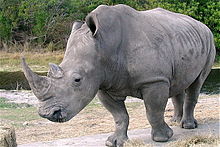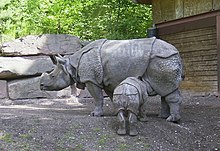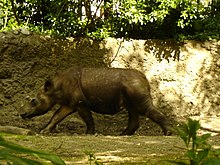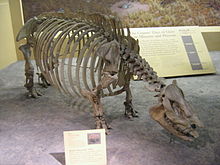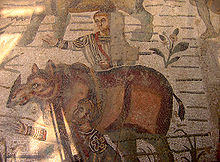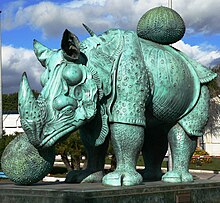Rhinocerotidae
The rhinoceroses (Rhinocerotidae, from the Greek ρινός (rinós), 'nose' and κερος (keros), 'horn'), known as rhinos, are a family of mammals placentals of the suborder ceratomorphs belonging to the order perissodactyls.
There are currently five species: the white rhino and black rhino in Africa and the Javan rhino, Indian rhino and Sumatran rhino in Asia. According to the conservation status classification made by the International Union for Conservation of Nature, the Javan, Sumatran and black rhino species are "critically endangered"; the one from India is considered “vulnerable” and the white one “near threatened”.
In Spanish, in addition to the term rhinoceros, there is the word abada to name these animals. Coming from the Portuguese abada, which is used to designate the female rhinoceros; its use is currently limited.
Features
The word "rhino" (ρινόκερος) comes from the Greek terms rhino (nose) and kera (horn), and literally means "horned nose" and alludes to the characteristic horns on the snout, which are also a valued trophy and the main reason for hunting. Unlike the horns of other species, such as antelopes, those of rhinos do not have a bony core, but are instead made of keratin, the same substance that forms hair and nails in other mammals. The two African species and the Sumatran rhinoceros have two horns, while the Indian and Javanese have only one.
The rhino family is characterized by its large size, being one of the few species considered to be megafauna existing today, along with elephants and hippos; all species can exceed at least one ton in weight. All are herbivorous, and have thick, tough skin, 1.5-5 cm thick, made up of overlapping layers of collagen. They have relatively small brains for their body size (between 400 and 600 g). Although they generally eat leaves, their ability to ferment food in the colon allows them to survive by consuming more woody plant matter, such as roots and branches, if necessary. Unlike other perissodactyl species, African rhinoceros species have no teeth at the front of their mouths, using powerful premolars and molars for chewing to crush plant-based food. The dental formula varies from species to species, but in general it is:
| Dentition |
|---|
| 0-1.0.3-4.3 |
| 0-2.0-1.3-4.3 |
Rhinos have a keen sense of smell and sensitive hearing, but very poor eyesight. Their maximum life expectancy is about 60 years. The head and body length is 240 to 315 cm in the Sumatran rhinoceros and 335 to 420 cm in the white rhinoceros. The weight, which is 800 kg in the Sumatran rhinoceros, can reach 3600 kg in the white rhino, considering it the second largest land animal after the elephant.
All species are perissodactyls; that is to say, they have a more developed central toe on each leg, which serves as their main support, and two lesser toes on the sides. That gives your prints the characteristic look of an ace of clubs. In the case of the white and Indian rhinoceros, adult males are much larger than females, but in all other species males and females are similar in size.
Rhinos have poor vision, although they are able to distinguish a stationary person up to 30m away. The eyes are located on both sides of its head. Their hearing is very fine, and the ears are of the tubular type, moving rapidly in the direction from which the sound comes. But his most developed sense is smell; the amount of olfactory tissue in the snout exceeds the size of the brain.
Food
All rhinos are herbivores and require a large amount of food daily to maintain their large bulk. They can tolerate relatively high-fiber foods in their diet, thanks to their colon's ability to ferment and digest woody plant tissue, but prefer softer, more nutritious parts when available. The two African species of rhinoceros have lost their front teeth, and although the Asian species retain incisors (and the Sumatran rhinoceros even canines), these parts have been adapted more for fighting than for feeding. However, each species has adapted to the consumption of a type of plant matter. The black rhinoceros has a prehensile upper lip which it uses to break the ends of the branches of woody plants. The white rhino, on the other hand, has an elongated skull and wide lips that it uses to graze short grasses. The Indian rhinoceros also has a prehensile upper lip, which it uses to obtain tall grass and small shrubs. Both the Javan and Sumatran rhino often cut down small trees to eat their leaves and shoots, and all species except the white include some fruit in their diet. All rhinos drink almost daily, but in arid conditions they can survive four to five days without drinking. The Indian rhinoceros spends long periods in the water, while the African species tend to prefer to wallow in the mud. Although the water refreshes them, the mud protects them from being bitten by flies and other insects.
Playback
Female white and Indian rhinos begin their sexual cycles at around five years of age, and give birth to their first young at six to eight years of age. Female black rhinos, which are smaller, are fertile a year earlier. Generally, all species have a single calf per birth, although the presence of two breasts has led to speculation about the possibility of gestation of two calves in exceptional cases. The interval between successive procreations is at least twenty-two months, although it is normal for it to vary between two and four years. The young are small at birth; they weigh about 65 kg in the cases of the white and Indian rhino and 40 kg in the black rhino, and can keep up with their mothers three days after birth.
Males reach reproductive capacity at seven to eight years of age, but usually do not reproduce for at least ten years. A peculiarity of rhinos is that the testicles do not descend into the scrotum, and the penis, when retracted, is directed backwards. Females have two breasts located between the two hind legs. Births occur in any month of the year, but in the case of African rhinos, births occur in greater numbers between the end of the rainy season and the middle of the dry season.
Behavior
The rhinoceros is a solitary and territorial animal. As a general rule, there is only association between a mother and her youngest calf, and adult males of all species only associate temporarily with females during the mating season. Among the white rhinos, and sometimes among the Indians, the immature animals form pairs, and sometimes form larger groups. The white rhinoceros is the most sociable of the five species, and females without offspring sometimes come together and accept the company of one or more immature animals, and may form persistent groups of up to seven individuals.
Both males and females always move in the same areas or territories, which vary in size depending on the species and gender (from 9 to 15 km for female white and Indian rhinos, from 3 to 90 km for black rhinoceros), and that they mark olfactorily through their feces and urine. Feces are deposited and then dispersed by kicking. When they patrol bordering regions of their territories, they urinate relatively frequently. In all species the territories of the females overlap extensively and there is no evidence of territoriality between them. Although, while female white rhinoceros usually have friendly contacts by rubbing their noses, those of the Indian rhinoceros generally respond aggressively to any proximity. The males, however, tend to fight any other male that invades their territory. Similarly, both the white and Indian rhino frequently respond with aggressive lunges when disturbed, but very often their charges are nothing more than blind lunges designed to scare off the intruder.
In their confrontations, the rhinos repeat the same gestures over and over again until one of them gives up. The animals facing each other press their horns against each other and push each other; they do not usually charge into one another, as other horned mammals do, as the combined mass of both would be enough to crush their skulls or snap their necks on impact. After the conflict is over, the dominant male proclaims his supremacy by expelling a spray of pulverized urine while the subordinate male withdraws. The owner of a territory that is defeated stops marking it with urine and spreading its excrement, and assumes the status of subordinate male.
Rhino longevity ranges from thirty-two years for the Sumatran rhinoceros to forty-five years for the white and Indian rhino, although they can live to be sixty years old or more.
Diversity
All species have 82 chromosomes (diploid number, 2n, per cell), except black rhinos, which have 84. This is the largest known number of chromosomes in any mammal.
The five living species are subdivided into four genera:
- The most primitive, Dicerhinus, arose in the Miocene, about 20 million years ago, and its only living representative is the rhinoceros of Sumatra. The European lanudo rhinoceros, already extinct, was also part of the same genre.
- Gender Rhinoceros It has two species, the rhinoceros of Java and India, originated about ten million years ago.
- Gender Dice, originated in the Middle Miocene (about 14.2 million years ago), is formed by the black rhinoceros, of which four subspecies are recognized (one already extinct).
- Gender Ceratotherium is the one of the so-called white rhinoceros, a gender split Diceoriginating from the initial Pliocene (about 5 million years ago). The species consists of two subspecies.
White Rhino
The white rhinoceros or square-jawed rhinoceros (Ceratotherium simum) is, after the elephant, the largest remaining land animal in the world, along with the Indian rhinoceros, which is comparable in size, and some male specimens of some species of hippopotamus. There are two subspecies of it; in 2005, South Africa was the largest natural habitat for the first of these, the southern white rhinoceros (Ceratotherium simum simum), with a population of 20,150, making the white rhinoceros the species most abundant rhinoceros in the world.
The white rhinoceros has a large, compact body and a proportionally larger head than other species, a short neck, and a broader chest. It can exceed 3 t, usually measures 3.35 to 4.2 m from head to tail, and measures between 150 and 185 cm at the withers. The largest specimen measured weighed about 3,600 kg. They present two horns on the snout; the front is larger than the rear, and is usually about 90 cm long, although it can reach 1.5 m in the largest specimens. The white rhinoceros has a kind of bulge on the nape that corresponds to the insertion of the ligament that supports the weight of its impressive head. The wide lips of the white rhinoceros allow it to make large bites at non-woody plants, thus making up for its lack of incisors. They usually feed on short grass and bushes.
Despite their name, the skin color of white rhinos is actually mostly gray, in shades that can range from yellowish-brown to stone gray. The confusion in the name comes from a mistranslation: as the first specimens were observed in South Africa, the original English name (white rhino) was taken from the Afrikaans name wyd, which doesn't actually mean "white"' (white), else "width"; the shape of the mouth was the main way to distinguish it from the black rhinoceros, whose mouth is not wide and square, but rather narrow and beaked.
Black Rhino
Although the name of the two African species was chosen to distinguish them, in reality it is very confusing, since both have practically the same color of skin, the same as the rest of the rhino species that exist today. There are four subspecies of black rhinoceros. The most numerous is the South-Central black rhinoceros (Diceros bicornis minor), which once ranged from central Tanzania south through Zambia, Zimbabwe and Mozambique as far north as and eastern South Africa. The southwestern black rhinoceros (Diceros bicornis bicornis) is best adapted to the desert and semi-desert savannahs of Namibia, southern Angola, and western Botswana and South Africa. The eastern black rhinoceros (Diceros bicornis michaeli) inhabits mainly Tanzania, and the western black rhinoceros (Diceros bicornis longipes) was declared extinct in 2011.
An adult black rhinoceros measures between 147 and 160 cm in height at the back, and between 3.3 and 3.6 m in length. Adults weigh between 800 and 1,400 kg, occasionally reaching 1,820 kg; females are usually smaller than males. They have two horns on the snout, made of keratin. The front usually measures about 50 cm, although in exceptional cases it can reach 1.4 m. Sometimes they can develop a third horn in a more backward position, always inferior to the two previous ones. The black rhino is smaller than the white and has a pointed mouth, rather than a wide and flat one. Unlike its African relative, it feeds mainly on shrubs and low leaves of trees rather than grasses and scrub; This allows both species to coexist in the same habitat without competing for natural resources. He is known to be violent and dangerous, as many people have died from his attacks.
Because of their size, adult rhinos are impossible prey, but their careless young would be easy prey for lions and hyenas, or, more bizarrely, crocodiles.
Indian Rhinoceros
The Indian rhinoceros or great unicorn rhinoceros (Rhinoceros unicornis) had its natural habitat in areas from Pakistan to Burma (even reaching China), but currently, and due to the action of the human being, It can only be found in freedom in some areas of Nepal and Assam, in India, in the areas of grasslands and forests that form the foothills south of the Himalayas.
The Indian rhino has thick, silvery skin that forms large folds over its body, giving it an even more armored appearance than other rhino species. Its size is comparable to that of the African white rhinoceros. Adult males are larger than females, weighing between 2,200 and 3,000 kg, while the latter weigh about 1,600 kg; The largest specimen that has been measured weighed about 3500 kg. Adult males measure between 1.7 and 2 m in height and up to about 4 m in length. The Indian rhinoceros has a single horn, which can measure between 20 and 100 cm.
Javanese Rhinoceros
The Java rhinoceros (Rhinoceros sondaicus) is one of the world's rarest and most endangered mammal species. According to 2002 estimates, as Only about 60 remain at large, spread out in small communities in Java (Indonesia) and Vietnam. Of all the rhinoceros species, the one from Java is the least known. These animals prefer dense tropical forests, areas of tall grass, and riverbeds with large tracts of marshes. Though once widespread throughout Asia, by the 1930s they had been hunted to extinction in India, Burma, Malaysia, and Sumatra, mainly for the reputed medicinal properties of their horn and blood.
Like its close relative, the Indian rhino, the Javan rhino has a single horn, and its skin forms large folds on its neck, back, and hindquarters, giving it a heavily armored appearance. The body of an adult male can measure between 3.1 and 3.2 m in length, and between 1.5 and 1.7 m in height. Adults can vary in weight from 900 to 1,400 kg, or from 1,360 to 2,000 kg, depending on sources. The horn of an adult male can reach 26 cm, while females have no horn.
Sumatra Rhino
The Sumatran rhino (Dicerorhinus sumatrensis) is the smallest extant rhinoceros species, as well as the hairiest, allowing it to survive at high altitudes in Borneo and Sumatra. Due to poaching, its number has gradually decreased, and it is one of the rarest and most endangered mammals, with only about 300 living specimens in the wild.
An adult Sumatran rhinoceros usually measures about 1.3 m tall at the withers, with a length of between 2.4 and 3.15 m and a weight of around 700 kg, although the largest specimen ever measured reached the ton. Like the African species, it has two horns, the larger one in front (25 to 79 cm), and the smaller one behind, usually less than 10 cm. Males have much larger horns than females. The hair can be dense (especially in pups), or sparse. The hair and skin color is reddish brown. The body is short, with stubby legs, and they also have prehensile lips.
Evolution
Members of the family Rhinocerotidae differentiated from other perissodactyls in the early Eocene: fossils of Hyrachyus eximus have been found in North America dating to that period. This little hornless ancestor looked more like a tapir or small horse than a rhinoceros. During the late Eocene period, three families, sometimes included in the superfamily Rhinocerotoidea, developed: Hyracodontidae, Amynodontidae, and Rhinocerotidae.
Hyracodontidae, also called "running rhinos," had adaptations focused on running speed, and would have resembled more horses than modern rhinos. The smallest hyracodontids were about the size of an average dog; the largest, the Indricotherium, devoid of horns, is believed to have been the largest terrestrial mammal to set foot on the planet, at seven meters high, ten meters long, and weighing about 15 tons. Like giraffes, it fed on the leaves of trees, and it spread throughout the Eurasian continent during the middle Eocene to the early Miocene.
The family Amynodontidae, also known as "aquatic rhinos," dispersed throughout North America and the Eurasian continent from the late Eocene to the early Oligocene. Amynodontids were similar to hippos in ecology and appearance, inhabiting rivers and lakes, and sharing most of their adaptations to aquatic life.
The family of which all modern rhinos are a part, Rhinocerotidae, first appeared in the late Eocene in Eurasia. The first members of the family were small and numerous; at least 26 genera lived in Eurasia and North America, until a wave of extinctions in the middle Oligocene wiped out most minor species. However, several independent lineages survived, such as the Menoceras, a rhinoceros the size of a pig with two horns located on one side and the other of its head, or the North American Teleoceras, with short legs and a stocky body, which lived 5 million years ago. The last rhinos on the American continent went extinct in the Pliocene.
Modern rhinos are thought to have spread across Asia beginning in the Miocene. Two species survived the most recent ice age and inhabited Europe until just 10,000 years ago. The woolly rhinoceros (Coelodonta antiquitatis) appeared in China a million years ago, and reached Europe about 600,000 years ago. Along with the woolly mammoth, it survived the last ice age, and both became numerous in Eurasia, but were eventually hunted to extinction by early humans. Another large rhinoceros species, the Elasmotherium sibiricum, also known as the "giant unicorn", measured two meters high, five meters long and weighed about 5 t, had a huge single horn and could run like a horse.
Of the species still extant, the Sumatran rhino is the most archaic, at around 15 million years old. It was closely related to the woolly rhinoceros, but not to any other extant species. The Indian and Javan rhinoceros are close relatives, members of a more recent Asian rhinoceros lineage, originating between 2 and 4 million years ago.
The origin of the two living African rhino species can be attributed to a common ancestor, Ceratotherium neumayri, from the late Miocene. Both lineages diverged in the early Pliocene, with the appearance of fossils of the most likely ancestor of the black rhinoceros, the Diceros praecox In fact, the African species are so close that they can successfully mate and reproduce with each other. Yeah.
Taxonomy
The following list presents the classification of known rhino genera. All preceded with the symbol "†" they have become extinct.
- Family Rhinocerotidae
- Subfamily Rhinocerotinae
- Tribu Aceratheriini
- †Aceratherium
- †Acerorhinus
- †Alicornops
- †Aphelops
- †Chilotheridium
- †Chilotherium
- †Dromoceratherium
- †Floridaceras
- †Hoploaceratherium
- †Mesaceratherium
- †Molassitherium
- †Perace
- †Plesiaceratherium
- †Proaceratherium
- †Protaceratherium
- †Sinorhinus
- †Subchilotherium
- Tribu Teleoceratini
- †Adopted
- †Brachydiceratherium
- †Brachypodella
- †Brachypotherium
- †Diaceratherium
- †Prosantorhinus
- †Shennongtherium
- †Teleoceras
- Tribu Rhinocerotini
- Rhinoceros
- †Rusingaceros
- †Gaindatherium
- Tribu Dicerhinini
- Dicerhinus
- †Coelodontics
- †Dihoplus
- †Lartetotherium
- †Stephanorhinus
- Tribu Ceratotheriini
- Ceratotherium
- Tribu Dicerotini
- Dice
- †Paradise
- †Miodicines
- Tribu Aceratheriini
- Subfamily Elasmotheriinae
- †Gulfoceras
- †Victoriaceros
- Tribu Diceratheriini
- †Diceratherium
- †Subhyracodon
- Tribu Elasmotheriini
- †Bugtirhinus
- †Caementodon
- †Elasmotherium
- †Hispanotherium
- †Huaqingtherium
- †Iranotherium
- †Kenyatherium
- †Menoceras
- †Ougandatherium
- †Parelasmotherium
- †Procoelodonta
- †Sinotherium
- Subfamily Rhinocerotinae
Cultural view of rhinos
In Eurasian culture, the rhinoceros (more specifically Elasmotherium) is surely the origin of the myth of the unicorn, a horse with a single horn in the middle of its forehead, which in later times was modified until taking the romantic form with which the term is associated today.
In Asia there are several legends, common in Malaysia, India and Burma, about rhinos that put out fires by stomping on them. They even have a special name in Malay, badak api ("fire rhino"). In them, the animal would emerge from the jungle at the moment a forest fire broke out to crush it under its paws and extinguish it. There may be some truth to the legend, but it is impossible to verify, as sightings of rhinos in the wild in Asia have become nearly impossible due to the pressure placed on the species by illegal hunting. This legend is clearly mentioned in the movie The Gods Must Be Crazy (Jamie Uys, 1980), as well as in an episode of The Simpsons.
Alberto Dürer created a famous engraving of a rhinoceros in 1515, although he had never seen one before. So, despite its anatomical inaccuracies, Dürer's Rhinoceros was considered for many centuries to be a true-to-life drawing of an Indian rhinoceros.
Rhino horn as a remedy
As already mentioned, the most obvious characteristic of the rhinoceros is its horn or horns, located above the snout and one after the other if there are two. Unlike other mammalian horns, the rhino's horn is composed of keratin and lacks a bone core. Rhinoceros horn has been used for centuries in traditional Chinese medicine, as well as for making dagger handles and ornaments in Yemen, Oman, and India.
A very common myth is that it is used in China as an aphrodisiac. In fact, it is used to treat fevers and convulsions. Attempts to stop using it as a remedy have had mixed results, as rhino horn is considered by many TCM practitioners to be a life-saver. lives, and of much better quality than their substitutes. However, China has signed the CITES treaty. In order to prevent poaching, in some areas rhinos are anesthetized and dehorned on a regular basis. Many countries maintain warehouses of rhino horn, legally trimmed or seized, which must be carefully monitored.
Contenido relacionado
Dichanthelium
Human embryology
Goniothalamus



